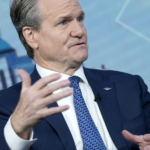Piper Sandler & Co. strategists, led by Michael Kantrowitz, suggest that companies with robust balance sheets have emerged as some of the top-performing stocks this year, and their shares may continue to rise. Investors’ concerns surrounding “zombie” companies that have sustained themselves due to low interest rates have led to a shift in the market. Macroeconomic uncertainties have directed US equity investors towards companies that can comfortably cover their interest expenses with earnings, a metric known as high interest-coverage ratios.
According to Piper Sandler’s analysis of 118 different factors within the Russell 3000, stocks with strong interest coverage have consistently outperformed their counterparts this year. The top-performing 20% of stocks in terms of interest coverage have shown significant outperformance relative to the bottom 20%.

The Federal Reserve recently maintained interest rates at a 22-year high, signaling a prolonged period of elevated borrowing costs. Investors are gravitating towards companies capable of bearing these expenses. The dramatic outperformance of firms with high interest coverage ratios might resemble a bubble, but Kantrowitz believes it is unlikely to deflate in the near future.
Piper Sandler’s strategists anticipate that this trend will continue until either zombie companies face bankruptcy or interest rates decrease substantially to sustain them. If higher interest rates persist for an extended period, this factor could define the decade.
For companies within the Russell 2000 Index, the disparity between the top 20% and the bottom tier is even more pronounced. This suggests that smaller companies with weaker balance sheets are penalized more severely than their larger counterparts. Piper Sandler’s strategists believe that interest coverage ratios for many of these companies may deteriorate in the future.
Overall, the Russell 2000 has declined approximately 5.6% this year, with potential implications for a second consecutive year of declines. Companies at higher risk of default in the next 12 months have experienced a more significant fall, plummeting by 26%, according to Bloomberg’s Issuer Default Risk model. Many of these companies operate in industries such as biopharma and energy.
These performance discrepancies can offer opportunities for investors who actively select stocks. By distinguishing between winning and losing companies, investors can avoid participating in a market where all assets move in lockstep. Active management across small caps is likened to the “Golden Age of Active Management,” as indexes are perceived as having lower quality due to an increase in non-earners and companies with no sales.
Bank of America Corp. has also advised clients to seek firms with strong cash flow even if growth expectations are relatively low, while avoiding “infinite duration” non-earners. The latter category comprises companies that may take an extended time to become profitable, raising uncertainty about their future success given the high borrowing costs to fund their investments.
The market landscape indicates that larger companies with weaker balance sheets are contracting. Since 2021, 50% more significant companies have downsized compared to those that have grown into large corporations, marking a unique reversal from prior decades. This trend suggests a “purge of weaklings,” positioning the S&P 500 Index favorably.
Rising interest rates have negatively impacted companies in multiple ways, increasing borrowing costs and weighing on profit growth. Companies previously considered “zombies” are particularly vulnerable in such an environment, as limited cash flow and the need to refinance debts during credit scarcity can lead to insurmountable challenges in staying afloat.









